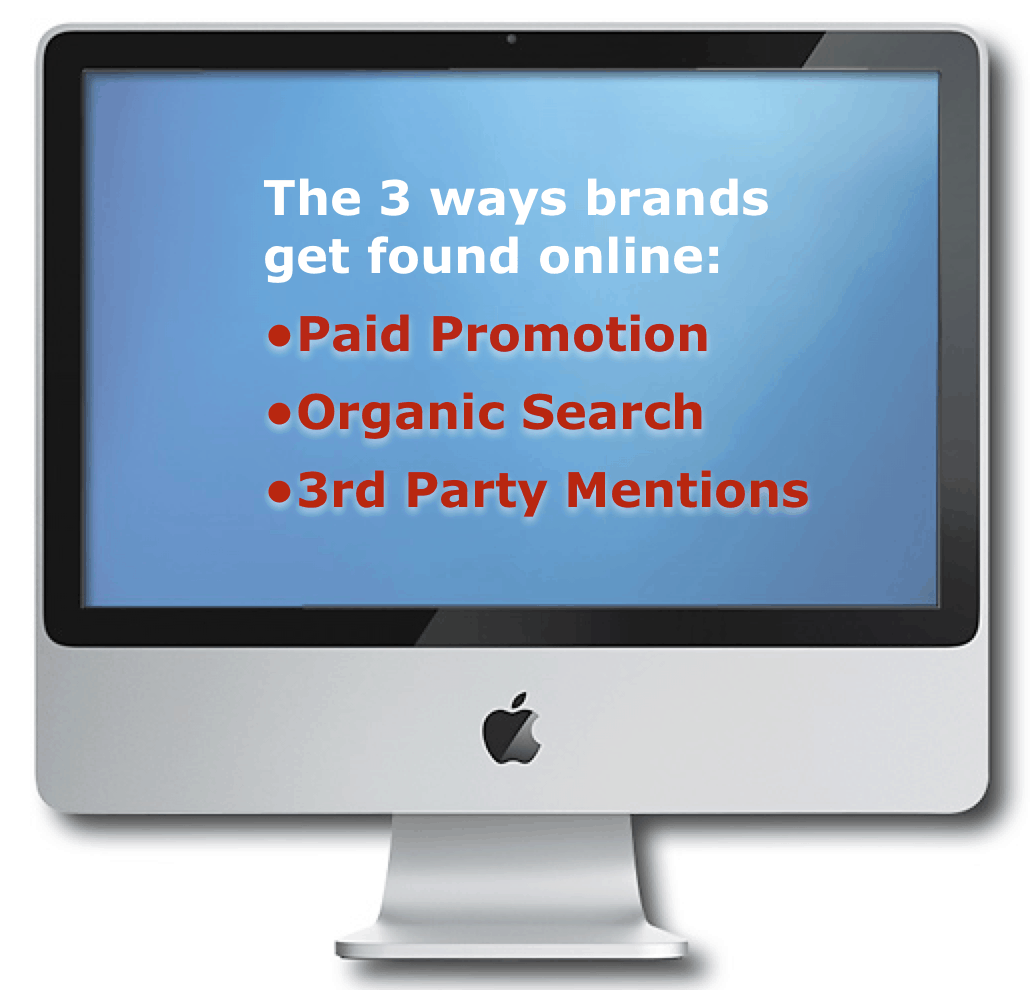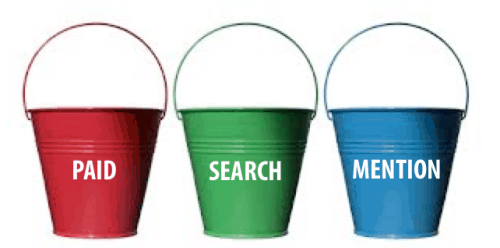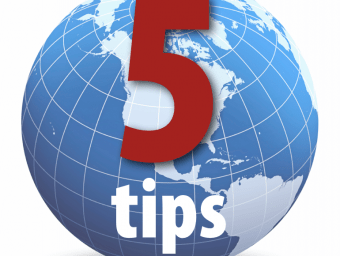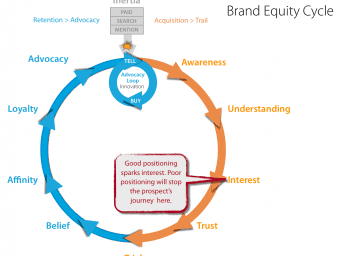Getting your brand found online
There are only three ways new prospects can find your brand online, be sure to use all of them. So you have set up a brand website with h...
13 May 2014 10847 ViewsThere are only three ways new prospects can find your brand online, be sure to use all of them.
So you have set up a brand website with helpful content for your prospects, perhaps you have an online store, your CEO posts weekly to your thought leader blog, your brand is active on several social media sites, and you’re running a contest. Now what? You need traffic for all these different web activities to make a difference. Optimizing your pages and waiting for Google to deliver prospects is only part of the answer. There is a lot more you could do to build awareness for your brand.
Brand’s online presence and awareness
 For many brands, building awareness is a key online marketing objective. But the task can be daunting considering the thousands of options available. Caught in a paradox of choice, marketers tend to focus on one or two trusted tactics and leave the rest to chance. As a result, many marketers are leaving a lot of eyeballs on the table when it comes to driving online awareness.
For many brands, building awareness is a key online marketing objective. But the task can be daunting considering the thousands of options available. Caught in a paradox of choice, marketers tend to focus on one or two trusted tactics and leave the rest to chance. As a result, many marketers are leaving a lot of eyeballs on the table when it comes to driving online awareness.
To help make this real, imagine your perfect prospect sitting at home in front of his computer. He has never heard of your brand. How is he going to find your website, online store, blog, social media sites, or online contest? Of course, if you knew who he was you could find him through outreach activities on social media or with email. But right now lets focus on the inbound challenge of being found by prospects online. There are hundreds of ways, but we wanted to chunk them down into manageable categories. We came up with three.
How to find my brand online? 3 Steps

When we are optimizing a brand’s web presence, we use them as a checklist to get the ball rolling and make sure we haven’t overlooked any possibilities.
Marketers often have a tendency to favor one of these approaches. You have probably run across one or two such people like the AdWords addict, the Facebook fanatic, the content king, or his crazy cousin the SEO zealot. They tend to focus a disproportionate amount of their attention on one area at the expense of the other two. I think this is a mistake. We’ve found all three to be most useful, especially in combination.
For sure, each of the three awareness tactics has its strengths for particular marketing purposes. AdWord addicts claim that they invest in a sure thing since they only pay for results and see a return on their investment immediately. SEO zealots will remind you that clicks on organic results beat paid results nine to one. Facebook fanatics will raise the quality vs. quantity argument citing that a 3rd party mention builds trust and leads to a quicker conversion to trial. They all have valid points. But is any one of these tactics any better or worse than another? Like your heart, lungs and spleen they all serve different purposes and all are important to overall health.
Paid Promotion
-
- Trigger Tactic: Buying exposure
- Public Trust Factor: Low — You recommending your brand
- Payback Time Scale: Short-term
- Description: This means paying someone money to gain access to their audience. Adwords is the most popular form of online paid promotion where you pay Google to gain access to their audience. But there are many variations on this theme such as Facebook ads, LinkedIn post promotion, banner ads, native content, etc. In all cases you are paying a gatekeeper to gain access to a third party’s proprietary audience. Buyer beware: Just because you can find people who will sell practically any form of exposure, regardless of how ethical it is, does not mean you should buy it (e.g., paid blog posts, fake review sites, or other forms of iffy native content published with the intent to essentially deceive with, or without, disclosure). If it seems deceptive, trust your better instincts and avoid it, even if it seems like everyone else is doing it.
-
- Pros:
- Immediate results.
- Easy to see cause and effect, and explain investment to superiors.
- Over time it can be highly predictable, proving the ability to calculate fairly precisely what the traffic and conversion return on a given investment will be.
- Pros:
- Cons:
- It can be expensive as a sole means of driving traffic and conversion. Especially as competition for your desired keyword increases.
- Budget allocated to paid promotion often displaces investment in developing the brand in other ways that would attract organic awareness and traffic.
- Like drugs, paid promotion can escalate into full-blown addiction because it offers a quick fix that can mask deeper problems.
Organic Search
-
- Trigger Tactic: Content marketing
- Public Trust Factor: Medium — Search engines recommending your brand
- Payback Time Scale: Mid-to-long term
- Description: For many people, the web is the first stop for solving problems, answering questions, and making purchases. And in each of those scenarios, Google is likely to be their gateway. For that reason, being able to rank high with relevant content can help drive those in buying mode to your solution. But just as important for future sales, it can preempt the buying process by acquainting them with your brand and creating a favorable bias even before the buying process has begun. The biggest factor in the success of this approach is the value of the content you create for your target audience. A close second is how well the content has been optimized for search.
-
- Pros:
- After the initial investment of creating the content it continues to deliver traffic indefinitely at no additional cost
- Content that is well optimized can attract a targeted audience, build understanding and trust and reinforce brand values and expertise
- Certain types of content allow you to preempt the buying process and establish relationships with prospects even before they are in buying mode
- Pros:
- Cons:
- Quality standards for content keep escalating and with it the cost of producing premium content
- The effect is more cumulative than immediate. Even with a good strategy, it still takes time to gain search rank and attract an audience
- While effective at gathering prospects around your brand, it may not necessarily make the cash register ring on the first visit (e.g., Rand Fishkin of MOZ cites how it takes seven and a half visits to their website – on average – to trigger a free trial of MOZ software).
3rd Party Mentions
-
- Trigger tactic: Online Networking, Content Marketing, Strategic Alliances
- Public Trust Factor: High — Trusted source recommending your brand
- Payback Time Scale: Variable
- Description: If there is a Holy Grail of online marketing, it seems to be “going viral” and that is driven by 3rd party mentions (a.k.a., word-of-mouse). This can be an organic like or share on a social site, word-of-mouth recommendation in a forum, a 3rd party Tweet or Facebook post that mentions your brand, a blogger who includes your brand in a post, or an article or review from a website. There are many things brands can do to encourage online mentions, such as posting content that fits the sharing profile of their audience, rewarding shares with recognition or requiring shares as part of an online contest. Mentions can also be arranged non-organically in the form of cooperation with other brands. Two non-competing brands that serve the same target audience (e.g., a peanut butter brand and a grape jelly brand) can join forces to provide exposure and/or access to each other’s audience. Whether organic or arranged, mentions typically are made by people or brands who do not charge for exposure to their audience, but benefit in some other way from mentioning your brand. This precludes the need to pay a gatekeeper for exposure to their audience.
-
- Pros:
- The most trusted source of online awareness
- Since peers tend to have a much higher correlation of needs and product preferences compared to the general public, mentions deliver the message to a pre-qualified audience
- It is a very economical way to spread your message, depending of course on how much you spend to trigger the buzz in the first place
- Pros:
- Cons:
- Mentions can be negative as well as positive. This risk should be mitigated with an active monitoring and rapid response program.
- Compared to tactics like online advertising, results are less predictable. Over time, however, you should be able to identify predictable patters of mentions.
- The bar continues to be raised in terms of what is remarkable enough to warrant mention. This means devoting greater creativity and/or cash to make a splash.

ONLINE AWARENESS: Find the right balance for your brand.In general, we have found a balanced approach allocating time and budget to all three, in proportion to your marketing goals, works best to drive awareness over time. However, there is no golden ratio that we know of. How you use these tactics to build your brand’s awareness online will depend on your specific situation and objectives. The only rule of thumb we have is that we never want to wind up in the position where we are dependent on paid promotion, like AdWords, to drive traffic online. Over time, we believe paid promotion should support a brand’s awareness efforts but not drive them. Of course there are exceptions, most notably sites looking for high-volume, one-off transactions. But in the majority of cases, over-dependence on paid awareness/traffic is indicative of deeper problems with the brand that are inhibiting organic or earned traffic.
The internet has provided marketers with an incredibly flexible and effective means of growing brand awareness. As you create your brand’s awareness development plan, consider using tactics from all three families to forge your brand’s fame in proportion with your budget and marketing objectives.
Read also: How to position your brand?
Like this post? You'll find more marketing insights in my new book: International Brand Strategy: A guide to achieving global brand growth, now available from booksellers globally. Order your copy here.







9 replies
Awesome post. I am totally agree with you. Internet and social media has a great hand in promoting our business and branding it.
A brand is nothing but the lifeline of any thriving business. Whether you are an artist, author, shop owner, a speaker, a strong brand can command a price premium, and develop customer loyalty which eventually translates into profits.
Brands only helps your business setup or business expansion.
Nice article. I would love to share this information over the social media sites and my colleagues. Thank for sharing such informative knowledge. keep posting…
Greetings! Very helpful advice in this particular post! It is the little changes which will make the most significant changes.
Many thanks for sharing!
Awesome post. I am totally agree with you. Internet and social media has a great hand in promoting our business and branding it. Very helpful advice in this particular post! It is the little changes which will make the most significant changes.
It is really difficult to understand how can I make my site popular online. Pros and cons are looking equal in every tactic.
OH MY GOD!!!
What a post. It is really awesome. It contains everything for building a good community. Full of information. HATS OFF!
This is a great post. I feel you covered all the necessary bases. This is very useful information for online review readers. Keep it up such a nice posting like this.Thanks for sharing..
nice post
nice imfo